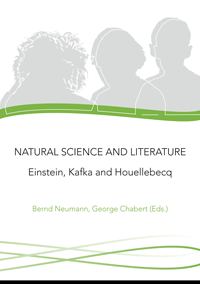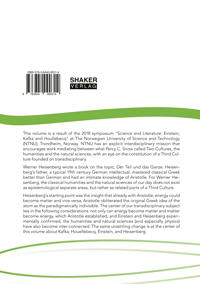
Shop : Details
Shop
Details
29,80 €ISBN 978-3-8440-9031-4Softcover156 pages216 g21 x 14,8 cmEnglish-GermanConference proceeding
April 2023
Bernd Neumann, George Chabert (Eds.)
Natural Science and Literature
Einstein, Kafka and Houellebecq
This volume aims in 6 articles, to discuss aspects of the relationship between natural science and literature.
Professor George Chabert raises in his article “Michel Houellebecq and the Ethics of Quantum Mechanics” that in his critique of French intellectual thought since 1945, Michel Houellebecq argues that prominent French theorists such as Sartre, Derrida, Deleuze, Lacan, and Foucault have ignored scientific matters, particularly in the fields of relativity and quantum physics. Their theories have thus become no more then pseudo-poetic verbiage and mysterious and empty formulas. Houellebecq argues that science, specifically quantum physics, challenges the idea of a materialistic metaphysics and calls for a redefinition of reality and knowledge. Overall, Houellebecq calls for a broader approach to understanding the world and humanity, and to the potential complementarity of science and literature in providing a more comprehensive understanding of the complexities of the world and human existence.
The second article “Whatever works: William James, on truth and pluralism in science and literature” is written by Senior Professor Sophie Matvienko. Science and literature usually refer to two regimes often distinguished from the truth, as they do not describe the same kind of world. While one can be verified and rationalized through laws, the other, although still regulated, is disconnected from any effort of verification. Pragmatism, developed by William James at the beginning of the 20th century, proposes both a method and a theory of truth that allow us to overcome this old antinomy, by rethinking what is considered to be true. Is true what works, or what pays off, according to James. The truth would be like a sort of good, expressing interests. What does one gain by bringing the idea of truth back to its beneficial effects? A vision of the world that James poses as pluralistic and melioristic, leading to Leibnizian possible worlds, in which we would have definite and assignable reasons to believe. Science and literature could then undergo the same pragmatic inquiry: what are these two worlds promising? And what if only the practical impact of these promises mattered in our relationship to the truth?
Director Joël Ganault takes the reader in the third article into Bruno Latour’s concept of how language is a requirement for thinking and that precedes natural science. He draws on examples from both classical literature as well as modern popular culture.
PhD Ralf Stefan Neumann writes in his article “Like Ships in the Night: Psychology and Physics in the beginning of the 20th Century” that the end of the 19th century heralded great changes in the two highly dissimilar sciences physics and psychology. By the year 1913, quantum mechanics had been established as a new branch of physics, its fundamental laws questing the existence of an objective reality independent of the mind of observers. The same year saw the rise of behaviourism in psychology, which denied consciousness any role in understanding human behaviour; thoughts and mental activity were seen as non-physical illusions. Despite grappling with similar problems related to mind, realism and the objectivity of measurements, physics and psychology never managed to initialize a meaningful dialogue concerning these matters.
“Kafka und Quantentheorie, oder auch: “Electrischer Prometheus”” is Professor emeritus Bernd Neumann’s contribution, in German. Here he makes valid the point that Franz Kafka’s writing is totally dependent on the influence he had living in Prague, meeting with Einstein, and discussing his theories. To show this Neumann gives a glimpse into the intellectual life in Prague at Kafka’s time together with a presentation of scientists working closely with Einstein at the time.
The final article, in German by PhD Barbara Di Noi, “Entropie der Moderne: Kafka und die Skulptur” she claims that in Kafka's statue motif, semiotics and hermeneutics have grown together in an exemplary manner. These can therefore be considered the epitome of Kafka's images and metaphors, which are an interpretation request without allowing them. Also, Kafka was different from other representatives of the classical modern as sculpture no longer falls exclusively under the category of the beautiful and the transfiguration of the human body; the moment of solidification, which is exemplified in what is displayed in this pictorial motif is by no means the antithesis to movement and mobility of writing: statues, rather than literal "motifs," are proper ones. To understand the driving forces behind the movement of the starting and keeping writing going; on the other hand, they embody the antithetical danger of stagnation, that threatens the flow of writing. In fact, Kafka's dialectics of writing overlap that antithesis of streams and sticks from which the contradictory essence of life itself is made.
Professor George Chabert raises in his article “Michel Houellebecq and the Ethics of Quantum Mechanics” that in his critique of French intellectual thought since 1945, Michel Houellebecq argues that prominent French theorists such as Sartre, Derrida, Deleuze, Lacan, and Foucault have ignored scientific matters, particularly in the fields of relativity and quantum physics. Their theories have thus become no more then pseudo-poetic verbiage and mysterious and empty formulas. Houellebecq argues that science, specifically quantum physics, challenges the idea of a materialistic metaphysics and calls for a redefinition of reality and knowledge. Overall, Houellebecq calls for a broader approach to understanding the world and humanity, and to the potential complementarity of science and literature in providing a more comprehensive understanding of the complexities of the world and human existence.
The second article “Whatever works: William James, on truth and pluralism in science and literature” is written by Senior Professor Sophie Matvienko. Science and literature usually refer to two regimes often distinguished from the truth, as they do not describe the same kind of world. While one can be verified and rationalized through laws, the other, although still regulated, is disconnected from any effort of verification. Pragmatism, developed by William James at the beginning of the 20th century, proposes both a method and a theory of truth that allow us to overcome this old antinomy, by rethinking what is considered to be true. Is true what works, or what pays off, according to James. The truth would be like a sort of good, expressing interests. What does one gain by bringing the idea of truth back to its beneficial effects? A vision of the world that James poses as pluralistic and melioristic, leading to Leibnizian possible worlds, in which we would have definite and assignable reasons to believe. Science and literature could then undergo the same pragmatic inquiry: what are these two worlds promising? And what if only the practical impact of these promises mattered in our relationship to the truth?
Director Joël Ganault takes the reader in the third article into Bruno Latour’s concept of how language is a requirement for thinking and that precedes natural science. He draws on examples from both classical literature as well as modern popular culture.
PhD Ralf Stefan Neumann writes in his article “Like Ships in the Night: Psychology and Physics in the beginning of the 20th Century” that the end of the 19th century heralded great changes in the two highly dissimilar sciences physics and psychology. By the year 1913, quantum mechanics had been established as a new branch of physics, its fundamental laws questing the existence of an objective reality independent of the mind of observers. The same year saw the rise of behaviourism in psychology, which denied consciousness any role in understanding human behaviour; thoughts and mental activity were seen as non-physical illusions. Despite grappling with similar problems related to mind, realism and the objectivity of measurements, physics and psychology never managed to initialize a meaningful dialogue concerning these matters.
“Kafka und Quantentheorie, oder auch: “Electrischer Prometheus”” is Professor emeritus Bernd Neumann’s contribution, in German. Here he makes valid the point that Franz Kafka’s writing is totally dependent on the influence he had living in Prague, meeting with Einstein, and discussing his theories. To show this Neumann gives a glimpse into the intellectual life in Prague at Kafka’s time together with a presentation of scientists working closely with Einstein at the time.
The final article, in German by PhD Barbara Di Noi, “Entropie der Moderne: Kafka und die Skulptur” she claims that in Kafka's statue motif, semiotics and hermeneutics have grown together in an exemplary manner. These can therefore be considered the epitome of Kafka's images and metaphors, which are an interpretation request without allowing them. Also, Kafka was different from other representatives of the classical modern as sculpture no longer falls exclusively under the category of the beautiful and the transfiguration of the human body; the moment of solidification, which is exemplified in what is displayed in this pictorial motif is by no means the antithesis to movement and mobility of writing: statues, rather than literal "motifs," are proper ones. To understand the driving forces behind the movement of the starting and keeping writing going; on the other hand, they embody the antithetical danger of stagnation, that threatens the flow of writing. In fact, Kafka's dialectics of writing overlap that antithesis of streams and sticks from which the contradictory essence of life itself is made.
Keywords: Dritte Kultur; Werner Heisenberg; Aristotle
Available online documents for this title
DOI 10.2370/9783844090314
You need Adobe Reader, to view these files. Here you will find a little help and information for downloading the PDF files.
Please note that the online documents cannot be printed or edited.
Please also see further information at: Help and Information.
Please also see further information at: Help and Information.
| Document |  | Document | ||
| Type |  | |||
| Costs |  | 22,35 € | ||
| Action |  | Purchase in obligation and download the file | ||
| Document |  | Table of contents | ||
| Type |  | |||
| Costs |  | free | ||
| Action |  | Download the file | ||
User settings for registered online customers (online documents)
You can change your address details here and access documents you have already ordered.
User
Not logged in
Export of bibliographic data
Shaker Verlag GmbH
Am Langen Graben 15a
52353 Düren
Germany
Am Langen Graben 15a
52353 Düren
Germany
Mon. - Thurs. 8:00 a.m. to 4:00 p.m.
Fri. 8:00 a.m. to 3:00 p.m.
Fri. 8:00 a.m. to 3:00 p.m.
Contact us. We will be happy to help you.



